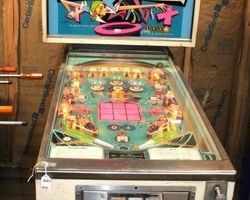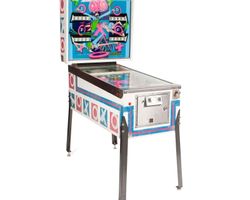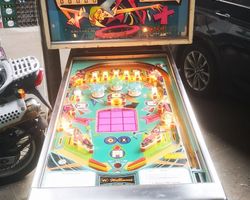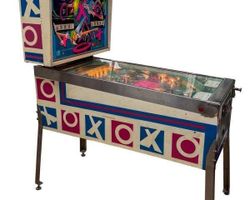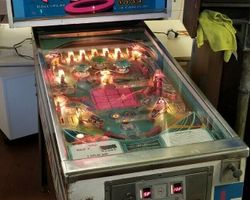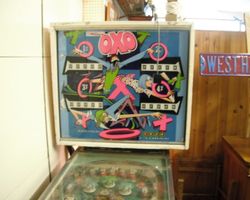
Average Prices: USD $300 to $700
Produced: August, 1973
Production Run: 7,053 units
Machine Type: Electro-mechanical
Players: 4
Design by: Norm Clark
Art by: Christian Marche
Williams Electronic Games, Incorporated, introduced a distinctive electro-mechanical (EM) pinball machine in August 1973: OXO. This four-player machine, designed by Norm Clark with artwork by Christian Marche, brought the familiar parlor game of tic-tac-toe to the pinball playfield, offering a fresh objective within the traditional pinball format. The concept for OXO evolved from an earlier, unproduced two-player version from 1972, provisionally named 'Triple X', demonstrating Williams' commitment to adapting the simple yet engaging puzzle for the arcade environment. With 7,053 units produced, OXO represents a substantial production run for its era, indicating a strong market presence and acceptance. Production began on August 31, 1973, with units shipped consistently through early 1974. The machine was offered to distributors at $710.00, reflecting the standard pricing for a complex EM game of its time.
Signature Features and Design
The defining element of OXO is its central tic-tac-toe matrix, prominently lit from underneath the playfield. This grid, consisting of nine distinct spaces, is the primary focus of player interaction and scoring. Complementing this, a unique mechanism between the flippers features a flipping indicator that alternates between "X" and "O", dictating which symbol the player is currently trying to light on the grid. This simple yet effective feature fundamentally alters player strategy by introducing an element of control, or sometimes lack thereof, over the symbol being targeted.
Christian Marche's artwork for OXO is a standout feature, characteristic of his style from the 1970s. The playfield and backglass are adorned with vibrant, almost Caribbean hues of pink, aqua, and green, creating an energetic and visually appealing aesthetic. Marche's distinctive "pointy people" style populates the backglass, contributing to a cohesive visual identity that is both whimsical and dynamic. This artistic choice elevates the machine beyond a mere game, making it a piece of functional art. The cabinet design, a standard form for Williams at the time, features complementary artwork that ties the entire visual package together. The underlying mechanical systems, including a "stacked" relay bank underneath the playfield, speak to the intricate engineering required for EM machines.
Playfield and Mechanics
The playfield layout of OXO is meticulously designed around its central tic-tac-toe mechanic. Two flippers at the bottom provide primary control, while three pop bumpers and two slingshots are strategically placed to interact with the ball and, crucially, influence the "X" or "O" selection. Three standup targets and two kick-out holes offer scoring opportunities and direct the ball's movement.
The upper section of the playfield features rollovers that are key to lighting the top row of the tic-tac-toe grid. These shots require precision, especially after the initial plunge, and present a consistent challenge to players attempting to complete the upper line. The lower left and right corners of the grid are primarily lit by guiding the ball through the inlanes, demanding accurate flipper work and controlled nudging. A "hidden orbit shot" also exists, rewarding skilled players who discover and execute it.
The playfield's design philosophy centers on engaging the player with the tic-tac-toe objective. While the core concept is simple, the layout encourages a fast, lively game, particularly when the machine is set up with a steeper angle. The arrangement of targets and bumpers ensures that the ball frequently interacts with the X/O selection mechanism, creating a dynamic interplay between skill and the game's inherent randomness. The overall aesthetic, with its vibrant colors and clear lighting of the grid, enhances player immersion, making the primary objective unmistakable.
Gameplay Dynamics
The gameplay mechanics of OXO revolve entirely around completing a line of three "X"s or "O"s on the nine-space grid. At any given moment, the player is either attempting to light an "X" or an "O", determined by the indicator between the flippers. This indicator flips between symbols when the ball strikes certain pop bumpers or slingshots, adding a layer of strategic decision-making and sometimes, frustration, as players may be aiming for an "X" when the machine is set to light "O"s. Each time a designated target or lane is hit, a corresponding square on the tic-tac-toe grid lights up with the active symbol.
The progression of the game is straightforward: light three of your symbol in a row, either horizontally, vertically, or diagonally, to earn significant bonuses, extra balls, or special points. The end-of-ball bonus system further rewards consistent play and completion of game objectives. Challenges arise from the difficulty of consistently hitting specific targets to light desired squares, especially the upper rollovers that feed the top row of the grid. Achieving the lower corner lights often depends on the ball successfully navigating the inlanes, which requires precise flipper control.
Player strategies often involve a combination of precise shooting and skillful nudging. Players learn to anticipate how their shots will interact with the bumpers and slingshots, trying to influence the X/O indicator to their advantage. Despite the seemingly simple objective, mastering OXO involves managing the ball's flow, capitalizing on the currently active symbol, and making the difficult shots required to complete a line. The satisfying 'clack' of the EM relays and chimes accompanies each successful light and score, providing immediate auditory feedback to the player's progress.
Reception and Legacy
OXO garnered a generally positive sentiment within the pinball community, often described as an enjoyable and engaging machine that frequently prompts players to desire "one more game." Its strengths are rooted in its unique tic-tac-toe theme, which provides a clear and accessible objective for both casual players and pinball enthusiasts. It is frequently cited as a good family game and a compelling multi-player experience, thanks to its competitive yet simple premise. The fast-paced gameplay, especially when set up with a steeper incline, is a recurring positive, demanding and rewarding good ball control and nudging skills. Christian Marche's artwork, particularly the vibrant color scheme and the distinctive "pointy people" on the backglass, consistently receives praise as a strong aesthetic element that contributes to the machine's charm.
However, feedback also highlighted some perceived weaknesses. Some players found the playfield layout could make it challenging to consistently return the ball to the upper areas, limiting shot variety once certain initial goals were met. The mechanism that alternates between "X" and "O" was sometimes viewed as too random, reducing a sense of player control over the desired symbol. While some found the game challenging, others felt it could be too easy to "beat" or that the scoring might become unbalanced with certain bonus multipliers. The characteristic Williams chimes, while authentic to the era, were occasionally noted as potentially irritating by a segment of players who preferred the sound profiles of other manufacturers. The physical "X-O change button" between the flippers, while a minor design detail, was occasionally noted for its high relief, which could be an slight impediment during intense play.
Despite these criticisms, OXO has maintained a respectable reputation. Its distinct gameplay, built around a widely understood game, makes it stand out from many other EM machines of its time. Its influence can be seen in later machines that similarly tried to incorporate existing game concepts, such as Bally Midway's 1984 'X's & O's', which explored a similar theme with electronic technology. OXO remains a noteworthy example of Williams' electro-mechanical era, a machine that successfully translated a classic game into a pinball experience, continuing to provide engaging and skill-testing play decades after its initial release.
Sponsored Links
 Ebay Listings
Ebay Listings
 Auction Results
Auction Results
| Cost | Location | Date |
|---|---|---|
| USD $471 |  Tennessee, United States Tennessee, United States |
31 July, 2025 |
| EUR €1,999 |  Nordrhein-Westfalen, Germany Nordrhein-Westfalen, Germany |
06 July, 2025 |
| USD $280 |  Arizona, United States Arizona, United States |
14 January, 2025 |
| USD $1,400 |  United States United States |
06 May, 2023 |
| USD $350 |  Missouri, United States Missouri, United States |
16 September, 2022 |
| USD $1,150 |  Indiana, United States Indiana, United States |
07 July, 2022 |
| GBP £522 |  London, United Kingdom London, United Kingdom |
25 March, 2022 |
| EUR €405 |  Nordrhein-Westfalen, Germany Nordrhein-Westfalen, Germany |
28 November, 2021 |
| GBP £700 |  United Kingdom United Kingdom |
04 January, 2021 |
| USD $450 |  Georgia, United States Georgia, United States |
30 October, 2020 |


Private Policy · Search Website · Contact Us
As an eBay Partner, we may earn a commission from qualifying purchases made through links on this site, at no additional cost to you.
All trademarks and copyrighted materials remain property of their respective owners. All other content copyright 2007 - 2026 Pinpedia.

